Does This Really Matter?
In principle, smart home hubs are all the same. They integrate multiple technologies and provide app control and automation of your smart devices. The difference lies not in what they do but in how they do it, and this difference plays a key role in determining performance, reliability, cost, convenience and longevity. With that in mind, lets take a look at the pros and cons of cloud-managed and locally-managed smart home hubs.
Locally-Managed Smart Hubs
Locally-managed systems came first, largely because that was the only way to do it in the early days (pre-Internet, pre-IoT). Some early hubs were tricked-out security panels (HAI, Elk); others were proprietary dealer-installed controllers (Crestron, Control4); some were computer-based DIY systems (HomeSeer, Indigo, mControl). In all cases, the hub was the focal point for the system and it managed all commands and automations.
Anatomy of Locally-Managed Automation
The diagram below illustrates the steps required to execute a typical locally-managed automation. In this case, the hub is programmed to turn on a light when a sensor detects motion.

- Motion is sensed and broadcasted to the hub.
- Automation rules execute on the hub.
- Hub sends the ON command to the light.
PROS
- Reliability – The failure points for a locally-managed system are limited to the equipment and software. Internet connectivity is only required for remote access.
- Performance – Automation rules are processed on the hub itself. This helps to keep latency (delays) to a minimum.
- Dedicated Automation – Locally-managed hubs process automation rules for one system only. Load sharing is not required. Again, this speaks to performance.
- Local Access – Web and touchscreen access are available on the home’s local network. Internet connectivity is not required for local access.
- Privacy – Sensitive data (schedules, automation rules) are stored locally on the hub.
- Update Management – Update your hub if and when you want, on your schedule, on your terms.
- Future Proofing – Locally managed hubs don’t rely on a web service, nor do they rely on the company health of the manufacturer. Barring outright equipment failure, a locally managed hub should last a very long time.
CONS
- Cost – It does cost a bit more to construct a locally-managed hub. Onboard processors (CPUs) and RAM have to be sized for managing complex automations and large smart home systems. That said, you can still get a locally-managed system (like our HomeTroller Pi) for close to $100.
- Setup – Locally-managed systems are usually configured using desktop computers. App-based setup is less prevalent (at the moment) but this is changing.
HomeSeer Locally Managed Hubs
Cloud-Managed Smart Hubs
Cloud-managed hubs first hit the market in 2012 and over the next few years, their numbers grew rapidly. Brands included SmartThings, Revolv, Wink, Lowes (IRIS), Staples (Home Connect) and many lesser known brands. Many began life as crowd-funded projects. Today, the field has whittled down to just a few.
Anatomy of Cloud-Managed Automation
The diagram below illustrates the steps required to execute a typical cloud-managed automation. In this case, the cloud service is programmed to turn on a light when a sensor detects motion.
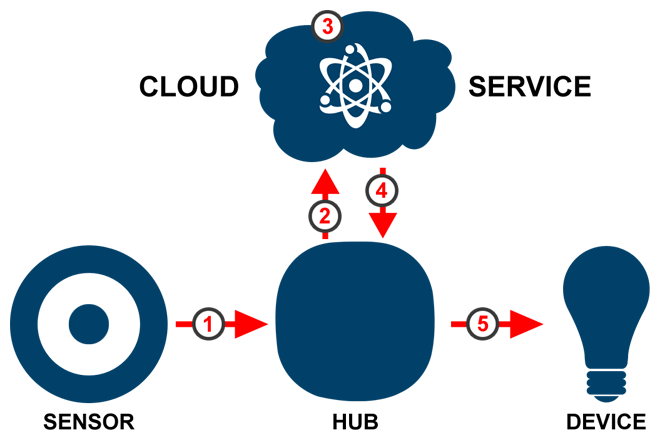
- Motion is sensed and broadcasted to the hub.
- Hub uploads that data to the cloud service for processing.
- Automation rules execute on the cloud service.
- Hub downloads command from cloud service.
- Hub sends the ON command to the light.
PROS
- Cost – Cloud-managed hubs are fairly cheap to build as they don’t require a lot of memory or processing power.
- Setup – These are mobile app-centric systems that do not require a desktop computer for setup or programming.
CONS
- Reliability – The failure points for a cloud-managed system include the local equipment & software. the cloud service equipment & software, and the Internet servers & software. Any outage will delay or prevent automations from running.
- Performance – All automation rules are processed by the cloud service. Even under the best of conditions, some degree of latency is unavoidable.
- Non-Dedicated Automation – Cloud service systems must handle hundreds or thousands of hub requests simultaneously. This will tend to increase latency, especially during peak usage periods.
- Local Access – If the Internet is down, the app won’t function. If the app is down, no local control is available.
- Privacy – Your sensitive data (schedules, automation rules) are stored in the cloud.
- Update Management – Your hub company will deploy updates on their schedule; not yours. Local access and automations will not work during the update process.
- Future Proofing – Cloud manged hubs are completely reliant on a cloud service to remain functional. If the service is shut down for any reason, the hub will be stop working. To date, these cloud-manage hubs have been rendered inoperable by service shutdowns or have switched to a paid subscription model:
- Revolv (shut down 2016)
- Staples Connect (shut down 2017)
- Lowes IRIS (shut down 2019)
- Wink (switched to paid subscription 2020)
Cloud-Managed Hubs
Still Available
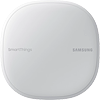
SmartThings
No Longer Available

Revolve, Staples Home Connect & Lowes IRIS have all shut down.
In Conclusion...
If performance and reliability are at the top of your list and you have the budget for it, you’ll want to get a locally-managed hub. Naturally, we’d prefer that you get one of ours! Other options include Vera and Hubitat.
If you’re on a tight budget or don’t have a home computer, a cloud-managed hub might be a better choice for you. These are generally less expensive and can be installed and programmed with just a smart phone or tablet.

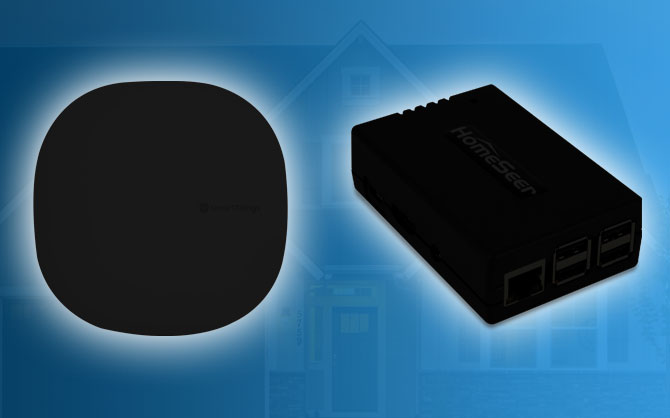

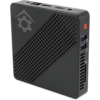
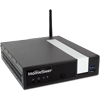





4 thoughts on “Choosing a Smart Home Hub? | Why Cloud vs Local Matters”
Hi Mark,
Nice review; we live in an area with spotty internet service which during any given week can be down or running slow. We have been running a home managed automation system built up around HomeSeer’s SEL and couldn’t be happier. The system is secure, compact and locally sustainable; I have no worries about the systems moment to moment functionality, being down, lag times or my access to mission critical system administration irregardless of the state of the internet. Remote access when required can be spotty due to internet outages however, I can’t imagine our systems automation relying on the whims of an entirely cloud based system communicating over an at times buggered up internet. In the years we have owned the system it has paid us back in peace of mind, paid for itself in subscription savings and has run flawlessly. Thank you!
👍 Thanks for taking the time to write Kirk. I’m glad the SEL is working well for you!
Does a local hub, such as yours, interface with a cloud based system, such as dLink, so your exterior motion detectors could turn dLink lights on and off?
John – There is a way to do this. D-Link is an IFTTT partner; so are we. So you can use and IFTTT applet to turn on your lights if a motion sensor in our system is triggered.
Comments are closed.